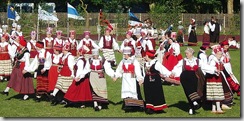At the start of term we have an equal number of singers in each part, but by the end of term, there are always too many altos (or sopranos or tenors – never basses)!
Does anybody else have this problem with their choir? Please say you do, and please say you have a sensible solution – it’s driving me nuts!
moving around the choir
Partly because we’re a community choir, partly because of the kind of material we do, but mainly because I think it’s good for people to exercise the whole of their vocal range, I encourage people to swap parts for different songs.
We don’t stick to the normal soprano/ alto/ tenor/ bass categories (we're never that high, and never so low!) and I don’t allocate people to a fixed part or role. We don’t use seats so people are free to move around.
Some songs have three parts, some five or more, some the ‘standard’ four. Not everyone is present every week for a variety of reasons. This is the background to the problem.
start as you mean to carry on ...
When we first start learning a song I try to make sure each part is made up of roughly an equal number of people.
The weeks go by, people come and go, I fit people who missed the first week into a part that is a little thin on the ground. Then suddenly, out of the blue, one week (usually when a concert is looming) EVERYONE seems to be singing alto!
There are no tenors to speak of, the tops look pretty thin on the ground, and the basses are the usual suspects. This is parts creep.
When I turn around people sneak from their part to another part without telling me. They do it on purpose (I'm sure of this!). What was once a well-balanced and orderly choir is now entirely out of kilter. And they deny it!
“I thought you guys were all singing tops when we started?”
“Oh, no, we’ve always been altos for this song”.
And so it goes.
... until it all goes pear-shaped
Of course, some people are in the ‘wrong’ part, some people deny ever having learnt the song in the first place, and some are just doing it (I’m sure of this too!) to wind me up. What’s worse – yes, even worse – is that then half the tops tell me that they can’t even do the concert after all!!!!!
Apart from nailing people’s feet to the ground, labelling them with a barcode on their forehead, making them wear different coloured shirts to represent the different parts, compelling everyone to learn every part of every song equally well, forcing the excess altos at gun point to rejoin the tops, or even culling the spare voices, what does one do??
Suggestions on a postcard, or leave a comment. PLEASE!!!
possible solutions
When I wrote the first version of this post, several people posted suggestions.
1st mate: “Give people a ‘range test’ to see what they can actually handle as opposed to what they think they can.”
I have done this in the past. There are difficulties with this approach though (of course!). The range test may tell you that you have a choir 3/4 of which is made up of altos (damn!). The arrangements I use are designed for community choirs so they are usually within everyone’s range. Although someone may be able to sing very low, they might not want to sing the low parts (what can you do??!!).
M. Ryan Taylor: “I like the idea of having them switch around on a part for an exercise, but I would definitely assign them a permanent part and write it down in the choir's roster.”
Write it down? Roster??!! I think you mistake my choirs for ‘proper’ choirs! We are far more informal than that, and I would never like to impose upon the singers in that way. Besides which, I would lose the roster or the singers would swear blind I wrote them down wrong in the first place!
Karen: “Sometimes I target individuals by saying: ‘You’re so good at picking things up, could you move to this other part?"’ Yes, I do use subtle emotional manipulation with my singers, but hey, whatever works!!”
Great idea Karen, but ... (you knew there would be a ‘but’ didn’t you?) most of the altos are there because they are under-confident, go for the middle ground and safety in numbers, so are least likely to be swayed by flattery and encouragement.
Babs: “Most groups I know of have a surfeit of sopranos, because they get the melody. What I have noticed is that group members tend to follow the strongest voices, so on lines with unassigned voices, there is a drift towards singing whatever the strongest vocalists are singing.”
In my choirs I don’t often give the sopranos the melody line (nasty man!), besides which, they probably have never heard the song before so it won’t help them. And if the song is well-arranged, ALL the parts will sing like melody lines and nobody will think they have the harmony.
You’re right about following the strongest (or loudest or most confident) voices. I try to spread them about to confuse people!
no biscuit!
Great ideas all, but no biscuit I’m afraid. All the decent solutions seem to involve some kind of formal accountancy with books and pens and serial numbers. Not really my style. In any case, you get it all set up and an entirely different group of singers turn up the following week. AND they’re not in the book!
So, my plea once more: any other ideas out there? Please do pop by and leave a comment.









